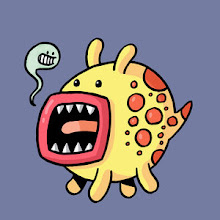I thought I'd do a step-by-step of how I go about creating my canvas paintings, as Katie of Green Bean Studio kindly posted one after I nagged her about how she goes about working in gouache! I love seeing the processes other artists use and am always intrigued by it, so hopefully someone will find this at least a tad interesting!

I used to be a very watercolour-obsessed artist and would shy away from heavy, thick acrylics as I thought they were very hard to control. However, during a not particularly great time in my life when I needed a change, I decided to just go for it and paint a huge canvas with acrylics. I still have the offending article on my wall at home just to show me how far I've come with the medium, but it looks bloody awful! XD
After much trial and error, I've finally found paints and brushes that work for me. I use a mixture of expensive and cheap acrylics as the two compliment each other very well when mixed (and saves on using up the expensive ones which come in smaller tubes). Liquitex are fantastic, almost gum-like paints that come in both transparent and opaque varieties, of which I mainly use opaque to achieve the bold, flat look I'm rather fond of. I like the student System 3 acrylics to go with these as they are cheap and plentiful. Not particularly good on their own but great when mixed with Liquitex. I love Loxley Deep-Edge canvases as the chunkiness of them makes them really nice tangible objects when finished and they are easy to hang or display.
Anyway, on with the steps! I usually paint three paintings at any given time if I'm working on a series of images. That way I don't waste time waiting for paint to dry! I'm currently working on my superhero pics for the con and am painting Reed Richards/Mr Fantastic, John Constantine/Hellblazer and Frank Castle/The Punisher. I'll focus on The Punisher for this post.

All pics start as a blue-line sketch. I just like the quality of blue pencil lead for sketching and it doesn't make a mess like graphite does when I transfer it to canvas.

Next, I trace the image to layout paper. If it needs flipping for any reason, I draw on the other side so the lead can carry to the canvas.

The images is transferred (very lightly) to the canvas, just by re-drawing over the image to press the lead into the canvas grain. I rarely, if ever, draw directly onto canvas.

Next, I mask off any areas I don't want smothered with background paint, which in this case is the whole image. I use drafting tape as opposed to masking tape which I find a bit too sticky, especially on paper which will rip when it is taken off.

Using my trusty craft knife/scalpel, I gently cut the shape of the image out. Now for paint!

I usually have ideas for colour schemes as I'm sketching the drawing in my sketchbook but more often than not, I make it up as I go, relying on instinct. We were always taught in University to make dozens of colour thumbnails beforehand but that bores me to tears! As The Punisher has a black and white outfit, I thought a grey tone would work well for the background. Depending on how thick the paint mixed is, two layers usually get the achieved flatness of the paint.

If I remember, a little shadow gets painted under the character before my favourite part....

...tearing off the drafting tape! So satisfying! Frank is ready to be flatted!

All the flat colours are painted with various thicknesses of brush (for those hard to reach areas), usually with two layers. Frank is now ready for the part that makes the picture really start to look good; the shading! But we'll leave that for part two as I've babbled on enough!
Hope this was of interest!










This is fascinating!!! I would never have guessed at your deft use of masking tape, what a great idea.
ReplyDeleteOh, and your wish is about to be granted. I'm uploading my photos for part 2 as I type....